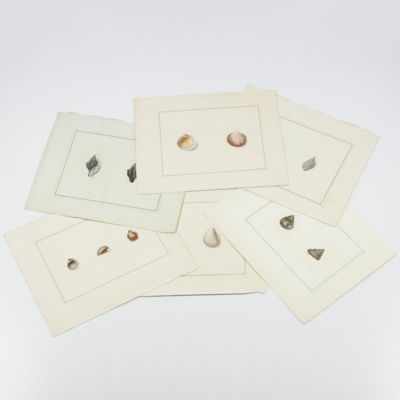Martyn, T.
Unknown illustrations for the "Universal Conchologist": Fine hand-coloured stipple engravings of lesser-known Indo-Pacific and South Pacific marine shells.
[London, the author], ca. 1780. Six oblong sheets (27.0 x 33.2 cm) with original stipple-engraved hand-coloured illustrations of shells.
A suite of six fine, spotless plates, of which five on wove paper and one on laid paper, containing excellent hand-coloured images over stipple engravings of gastropods and bivalves collected mainly during Captain Cook's first voyage. Usually each shell is represented by two views: the bivalves inside and outside, the gastropods from different angles. One shell is painted from three different sides. All but one of these shells can be identified as drawn and published by Thomas Martyn (1760-1816) in his Universal Conchologist. Although the images in this work are easily taken for original watercolours, the drawings are 'guided' by very weakly printed stippled outlines. Included are: "Buccinum aplustre Martyn" - the rare fasciolariid Latirus vexillulum (Reeve, 1842) from Caroline Island in the Southern Line Islands, Kiribati, Central Pacific; "Buccinum striatum Martyn" (the New Zealand muricid Haustrum lacunosum [Bruguière, 1789]); the top shell "Trochus canaliculatus Martyn" from "New Zealand" - Calliostoma canalicutum (Lightfoot, 1786) from the west coast of America; and "Lepas calyptra Martyn", from "the northwest coast of America", an unrecognized species, probably a capulid; the Indo-Pacific heart shells Lyrocardium lyratum (Sowerby II, 1842); and Acrosterigma biradiata (Bruguière, 1789). The presence of the latter two species is peculiar and spectacular, as they are not known from the officially printed editions of The Universal Conchologist. The second plate is not known at all. The format, with usually two views for each shell, and one species per leaf, is typical of Martyn and his Academy for the Painting of Natural History. The oblong rectangular cadre, however, is less usual and was not used in the regular editions of The Universal Conchologist. It was, however, used in a special "de luxe" edition, and in a precursor that remained unpublished and of which few copies are known. We have reason to believe that these six plates are from the precursor edition, based on the presence of the two heart shells, and on the format. The deluxe edition would not have a rough edge, and direct comparison shows that the arrangement of the figures is different. The borders are of the early type, described by Lyle as "four-line boarder ... a broad line between two narrow ones and a third narrow line outside these". They are drawn in by hand, not engraved, precisely as described by Lyle. All plates with one edge a bit rough, apparently from being removed from a book. The plates have been very professionally cleaned and are now in very nice condition, the colouring being strong and vivid. The plates look strikingly like original watercolours, because of the subtle printing technique and amazing colouring: they are often mistaken for watercolour drawings. Lyle [ Thomas Martyn's The Universal Conchologist: An early copy and a theory, in Journal of the Society for the Bibliography of Natural History 5(2), 1969].




